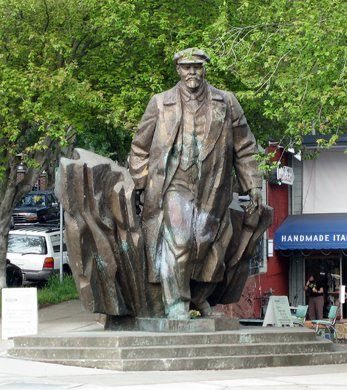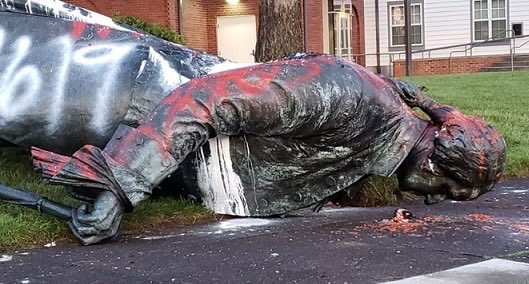The United States is gripped by a statue-felling frenzy that has not spared either the country's founding-President George Washington, author of it's Declaration of Independence Thomas Jefferson, or even, to the height of irony, the General who led the nation to victory in Civil War, Ulysses S Grant. However, a 16-foot tall statue of Vladimir Lenin in Seattle has shot into focus.
On Friday, Conservative portal The Daily Wire put out a tweet contrasting the state of two statues, one of President Washington in Portland, lying on the floor after being pulled down by protesters, and the other of Vladimir Lenin, the founder of USSR, in Seattle, standing in perfect health, undamaged by any kind of vandalism.
The message was clear: The Black Lives Matter campaign has transmogrified into a desecration of USA's history and has gone dangerously close to the ideology that the country fought in the Cold War. As expected, a furious Twitter war ensued between ideological opponents.

In fact, 'Lenin' soon became a top Trend on Twitter. Activist and Writer Charlotte Clymer responded to right-wingers by pointing out that the statue of the Russian leader is situated on private property. But this backfired as many drew her attention to the irony in using private property to defend the socialist titan's brazen image.
How Did it Get There?
But most people, including Americans, would be wondering: How the hell did this huge statue of a man who set up the regime that USA fought for around 40 years in an ideological/strategic war end up in this country? And who is the dissident responsible for proudly displaying it on his property?
Well, as it turns out, the history of the statue is quite interesting in itself. To begin with, it originated not on American soil but in the erstwhile Czechoslovak Socialist Republic, one of the East European satellite states of USSR. The sculptor of the bronze image was a Bulgarian, Emil Venkov. It went on public display in 1988, in the city of Poprad, in present-day Slovakia, just as the puppet regime was on its way down.

After the Velvet Revolution in 1989 that ended the Communist regime of Czechoslovakia, the statue was, like myriad others of Lenin, pulled down. It was condemned to lie in a scrapyard of the city, without any care. However, in 1993, an American man by the name Lewis Carpenter discovered it and decided to transport it back to his home country.
While not of much value, the transportation of the statue cost $40,000 at the time and required Carpenter to mortgage his house. But the American didn't intend the statue to be a symbol of his political affiliation. He instead, intended to start a Slovakian restaurant and have it placed on its premises. Sadly, Carpenter died in 1994 in a road accident.
The statue then went into the possession of an organization called Fremont Fine Arts Foundry, headed by Peter Bevis. He found the artistry in the statue compelling and decided to resist offers of buyers who intended to melt the statue for its bronze and got it installed in Fremont, a suburb of Seattle.
Questions Over the Statue
The reactions to the statue have been mixed. Last year, a group of Republican lawmakers in the State Congress introduced a bill to bring the statue down. However, the former Mayor of Seattle, Ed Murray, told a local radio station that while the statue can be troubling for many, it can also be seen as a bit of a joke.
The statue has faced its fair share of attacks from vandals and had to be moved from its earlier location to a new one. Only time will tell whether it would become a victim to American right's response to the statue-tearing fever of the ultra-left or live on as an ambiguous reminder of past.









